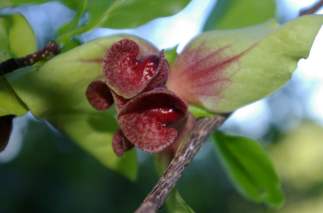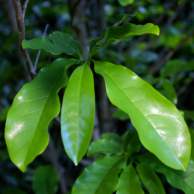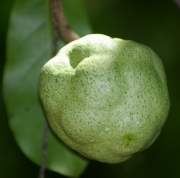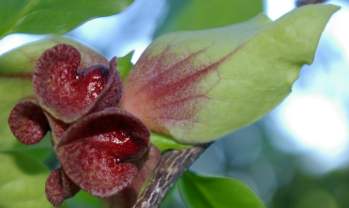Monodora junodii
Monodora junodii Engl. & Diels
Family: Annonaceae
Common names: green-apple (Eng.); groenappel (Afr.); ndzivila (xiTsonga); umKotshi (isiZulu)
SA Tree No: 107
Introduction
Imagine a tree with a flower like an orchid bloom; one so unusual that next to nothing is known about how to grow it. Would this not be a major garden status symbol? Imagine no longer; but read on and meet the green-apple tree.

Description
Description
Monodora junodii is a rather shrubby small tree up to 7 m tall, with smooth grey bark.

Leaves one-at-a-time (alternate or spirally arranged), drooping, roughly oblong or widest beyond the middle, up to 200 x 75 mm, shiny emerald green, hairless, stalked; margin without teeth.

Flowers solitary (hence the name), orchid-like, green or yellow-green with liver-coloured spots, or some petals liver-coloured throughout; usually after the first good rains (September to November in Kwazulu-Natal ). Fruits grey-green, lumpy-roundish, up to 55 mm in diameter, fleshy, edible but not palatable.

Conservation Status
Status
Green-apple is not listed in the Threatened Plants section of the SANBI website, and so one may assume that it is not under threat.
Distribution and habitat
Distribution description
Green-apple trees occur in sand forest and dry woodland on the eastern side of Africa from Tanzania southwards to the Maputaland region shared by Mozambique and Kwazulu-Natal. It is possible to deduce that the dry appearance of at least some of the range of this tree is due to rapid drainage rather than excessively low rainfall. In cultivation one would expect the trees to require a warm climate, moderate to high rainfall, and quite well-drained soil, with a not necessarily abundant supply of nutrients.
Derivation of name and historical aspects
History
Monodora junodii was described from two late 19th century specimens, one collected by Rev. Junod at Delagoa Bay, the other by the ubiquitous F.R.R. Schlechter at Lourenço Marques (both of these place names indicate the area surrounding Maputo, Mozambique). The genus name is derived from two Greek words, monos meaning one and doron meaning a gift; the combination refers to the solitary flowers of this tree. In the cartoon below, Ettie seems to be quite pleased with her single flower.
The specific epithet honours Rev. Henri Alexandre Junod (1863-1934), a missionary stationed for much of his career at Shiluvane in Limpopo Province . His collection of plants from there, the lowveld of Mpumalanga and parts of Mozambique, is an important early historical record of the flora of these areas. Fifteen species of Monodora have been described from tropical Africa, of which only M. junodii extends southwards to South Africa . There are probably a few more species in the equatorial rain forests awaiting description. The pantropical family Annonaceae includes some 112 genera and over 2000 species (Mabberley 1997). Although the family itself is relatively clearly defined, relationships of genera within the family are anything but clear. However, Monodora and Isolona (also tropical African) are usually regarded as forming a group separable from the other genera, and this group has been described as the subfamily Monodoroideae.
Ecology
Ecology
Despite the fact that the green-apple is widespread and apparently not under threat of extinction, it is nowhere either common or a significant feature of the vegetation. Its ecology therefore remains completely unstudied, and residents of the warm places where it grows may find the discovery of its pollinators and dispersal agents a worthy challenge.
Uses
Use
Pooley (1993) records that branches of green-apple are used for building huts. The fruits are edible but very dry, and the seeds make attractive necklaces when strung together. Seeds of M. myristica (Gaertn.) Dunal (calabash nutmeg; mainly West African but extending to Angola and the Kenyan shore of Lake Victoria ) are used as a nutmeg substitute and in indigenous medicine.

Growing Monodora junodii
Grow
Coates Palgrave (2002) indicates that the green-apple is difficult to establish, but I have seen a very bonny tree of this species evidently thriving in a garden in Kloof, near Durban . These trees are almost certainly frost-sensitive. Although their natural habitat is dry woodland and sand forest, the tree in Kloof is thriving in an area which receives some 1 075 mm of rain each year, and is quite often shrouded in mist.
As green-apple is a small tree, it is best suited to use as a feature tree in a small garden, or as part of a bush clump, preferably near a busy area where the orchid-like flowers can be enjoyed to best advantage.
Pooley suggests that it should be grown from seed, without giving any details. Because it is so seldom grown, virtually nothing is known about its requirements and problems. Soils in the suburbs above Kloof are derived from sandstone, and so not wonderfully retentive of moisture. In the grassland parts of the reserve, and in the surrounding suburbs, the soils are neither destitute of, nor spectacularly rich in humus. Probably the best advice that can be given to would-be growers of this tree is to read up on related trees that are grown as tropical fruit crops (sweetsop, soursop, cherimoya and other West Indian species of Annona), and follow recommendations for them.
References
- Balkwill, K., Boon, R., Coates Palgrave, M., Glen, H.F., Jordaan, M., Lötter, M., Schmidt, E. & Thomas, V. 2004. SAPPI Tree Spotting Lifer List. Jacana, Johannesburg .
- Coates Palgrave, M. 2002. Keith Coates Palgrave Trees of southern Africa, edn 3. Struik, Cape Town .
- Drummond, R.B. 1975. A list of trees, shrubs and woody climbers indigenous or naturalised in Rhodesia . Kirkia 10: 229-286.
- Glen, H.F. 2004. SAPPI What's in a name? Jacana, Johannesburg .
- Mabberley, D.J. 1997. The plant-book, edn 2. Cambridge University Press.
- Pooley, E.S. 1993. The complete field guide to trees of Natal, Zululand and Transkei. Natal Flora Publications Trust, Durban .
- Van Wyk, A.E. & Van Wyk, P. 1997. Field guide to trees of southern Africa. Struik, Cape Town.
- Von Breitenbach, F. 1965. The indigenous trees of southern Africa. Government Printer, Pretoria.
Credits
H.F. Glen
Kwazulu-Natal Herbarium
May 2006
Plant Attributes:
Plant Type:
SA Distribution: KwaZulu-Natal, Limpopo
Soil type:
Flowering season: Spring, Early Summer
PH:
Flower colour: Brown, Red
Aspect: Full Sun
Gardening skill: Challenging
Special Features:
Horticultural zones







Rate this article
Article well written and informative
Rate this plant
Is this an interesting plant?
Login to add your Comment
Back to topNot registered yet? Click here to register.